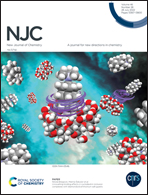A composite approach to synthesize a high-performance Pt/WO3–carbon catalyst for optical and electrocatalytic applications†
Abstract
In pursuit of efficient, cost-effective, and durable catalysts for the optical and electrochemical oxidation of methanol, platinum (Pt) nanoparticles deposited on a WO3–C support have an improved bandgap and electrochemical behavior as compared to Pt/C and Pt/WO3 electrocatalysts. Vulcan carbon was first purified and then functionalized, and the presence of oxygen-containing functional groups on the carbon was established from the FTIR spectrum. Platinum nanoparticles were deposited on the support by the reduction of a Pt-precursor under controlled conditions using sodium borohydride (NaBH4). The composition of the components in the catalyst (Pt/WO3–C) was set at Pt 10%, WO310%, and C 80% by weight. XRD describes the cell shape, volume, material density, and average crystallite size. TGA and BET studies describe the thermal stability and surface area of the synthesized electrocatalyst supports. TEM and FESEM were employed to visualize the uniform distribution of Pt nanoparticles on the different supports and the surface topography of Pt/WO3–C, Pt/WO3, and Pt/C. UV studies demonstrated the optical band gap from the Tauc plot of all three samples. The activities and durability of the catalysts for methanol oxidation were determined by using cyclic voltammetry. A comparison revealed that all of the relevant quantities, like specific surface area, durability, peak, and exchange currents, were appreciably higher for Pt/WO3–C. The heterogeneous constant for methanol oxidation by Pt/WO3–C in an acidic medium was 10 and 3 times higher than that of Pt/C and Pt/WO3, respectively. In electrochemical impedance studies, the charge transfer resistance values were elucidated from Nyquist and Bode plots. The higher increment in optical properties, as well as methanol electrooxidation performance, of the Pt/WO3–C catalyst is attributed to the abrupt removal of CO, facilitating methanol adsorption on fresh and regenerated Pt sites in the presence of WO3. This study has proved that WO3 inclusion into the support improves the optical features, proficiency, and durability of Pt/C.



 Please wait while we load your content...
Please wait while we load your content...